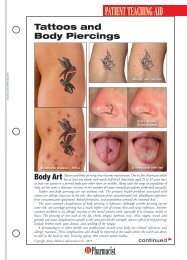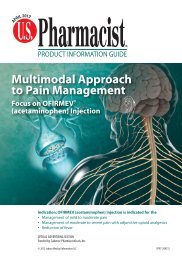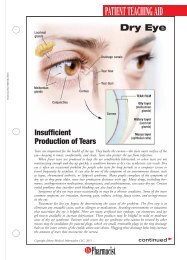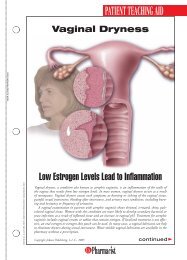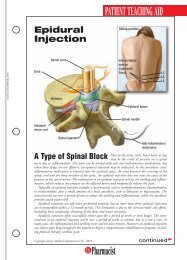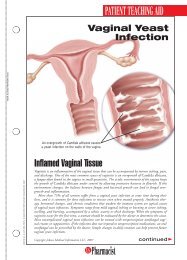OPIOID MAINTENANCE TREATMENTTable 2Characteristics of Options for Maintenance TreatmentBuprenorphine andBuprenorphine/NaloxoneMethadonePharmacologic Action Buprenorphine: partial agonist Full agonistNaloxone: full antagonistRoute of Administration Sublingual OralDosing Buprenorphine: 2-32 mg; naloxone: 20-30 mg initially, then 60-120 mg0.5-8 mg; combination: 4:1 ratioAdministration Daily to 3 times/wk DailyCommon Side Effects Headache, nausea, sweating, rhinitis, Cardiac dysrhythmia, hypotension, diaphoresis,constipationconstipation, nausea, vomiting, dizziness,sedationContraindications Need for ongoing opioid agonists for Hypersensitivitypain relief, hypersensitivityPregnancy Concerns Category C; combination not Category C; current standard of care inrecommended in pregnancy—replace pregnancywith methadone or buprenorphineAccessibility Physician’s office or opioid Opioid treatment programtreatment programRegulatory Concerns Physician may prescribe only with Physician may prescribe only to opioid-DEA-issued registration certificate code; dependent patients for up to 72 h as bridge30-patient census/prescriber, then 100- to treatment entry; only licensed opioidpatient census after 1st y; pharmacy treatment programs may dispense; federalmay dispense up to 30-day supply regulations govern dispensing frequencybased on schedule III(e.g., daily, 3 times/wk, wkly)Insurance Coverage Specific to type of insurance Specific to type of insuranceDEA: Drug Enforcement Administration.Source: Reference 25.agonism allows buprenorphine to have a ceiling effect onthe opioid effects at higher doses, making it safer in theevent of overdose.Naloxone is a mu-opioid receptor antagonist withpoor oral bioavailability owing to limited absorption andextensive first-pass metabolism. It has a rapid onset ofaction when given intravenously. Because it has ahigher affinity for mu-opioid receptors than heroin, morphine,or methadone, naloxone displaces these drugs fromreceptors and blocks their effects. 17Buprenorphine/naloxone (Suboxone) is available asa 4:1 fixed combination. Subutex (buprenorphine), awhite tablet, is available in 2-mg and 8-mg strengths;Suboxone is an orange tablet and is available in 2/0.5-mg and 8/2-mg formulations. Buprenorphine israpidly absorbed sublingually, and peak effects are reached90 minutes after administration. Naloxone does notaffect the pharmacokinetics of buprenorphine. The meanhalf-life of buprenorphine is 37 hours; that of naloxoneis 1.1 hours. 18Dosing: Because buprenorphine displaces the other opioidfrom mu-receptor sites and induces withdrawal, itshould be initiated only when the patient already hasevident signs of withdrawal; otherwise, the patient mightassociate the buprenorphine with withdrawal, therebyreducing adherence. The buprenorphine/naloxone combinationis the drug of choice for initiating therapy inboth U.S. and European guidelines. Buprenorphine maybe started alone at doses of 4 mg to 8 mg or in combinationin a 4:1 ratio to naloxone. A second dose of 4mg may be given in 2 to 4 hours, and the patient maybe given an additional dose of 2 mg to 4 mg to takehome in case of withdrawal within the next 24 hours.The physician should monitor for buprenorphine-precipitatedwithdrawal while the patient is in the office.This is not to be confused with withdrawal from underdosingof buprenorphine, which usually occurs in thesecond half of the 24-hour dosing interval. 16The maintenance dose may be achieved by doublingthe dose each day, to a maximum of 24 mg to 32 mg.If withdrawal symptoms arise at any time during the24-hour dosing interval, the dose is too low and needsto be increased. If induction occurs too slowly, thepatient may prematurely terminate treatment. Therefore,it is important for the practitioner to be diligentin monitoring the patient. When converting to or fromthe naltrexone combination, a 1:1 ratio of the buprenorphinedose may be used. 16When the maintenance dose is achieved, buprenor-46U.S. <strong>Pharmacist</strong> • November 2009 • www.uspharmacist.com
Table 3Potential Drug Interactions forMethadone and Buprenorphinephine may be administered from every other day to 3times weekly (e.g., Monday, Wednesday, and Friday) inorder to increase compliance and patient satisfaction.Every-4-day regimens have been associated with increasedwithdrawal symptoms. The daily dose may be doubledfor every-other-day dosing and also for thrice-weekly dosing,but Friday’s dose would be 2.5 times the daily dose. 16New patients should be advised that sublingual tabletsmust be dissolved under the tongue, as the medicationis much less effective if swallowed. 18 No more than twotablets should be taken at one time, to avoid swallowingthem by mistake. Wetting the mouth before placingthe tablets under the tongue may help them dissolvefaster. Full absorption may take up to 10 minutes.Patientsshould refrain from smoking for 10 to 15 minutes beforetaking the medication, as this seems to help the tabletsdissolve faster. 18Side Effects: Buprenorphine/naloxone is generally welltolerated. Side effects are associated mainly with buprenorphine,since naloxone is not readily absorbed. In clinicaltrials, the most common adverse effects were headache,withdrawal syndrome, pain, nausea, insomnia, sweating,rhinitis, constipation, abdominal pain, flulike syndrome,and flushing. 17OPIOID MAINTENANCE TREATMENTInteraction Methadone BuprenorphineIncrease Effects Alcohol Alcoholof Opioid Substitute Antidepressants Antiretrovirals• Fluoxetine • Atazanavir• Fluvoxamine • Indinavir• Paroxetine • Nevirapine• Sertraline• RitonavirAnti-infectives • Saquinavir• Ciprofloxacin Benzodiazepines• Erythromycin Fluvoxamine• Fluconazole Ketoconazole• KetoconazoleBenzodiazepinesCimetidineDecrease Effects Anti-infectives Carbamazepineof Opioid Substitute • Fusidic acid Phenobarbital• RifampinPhenytoinAntiretrovirals Rifampin• Abacavir• Amprenavir• Efavirenz• Nevirapine• Ritonavir• SaquinavirBarbituratesCarbamazepinePhenytoinSource: References 12, 16.Interactions: Buprenorphine goes through hepaticmetabolism via CYP3A4. The drug has thepotential for many of the same interactions asmethadone (see TABLE 3). One dangerous interactionto monitor for is the potentially fatalinteraction with benzodiazepines. 19 Concomitantadministration should be avoided. Compared withmethadone, buprenorphine may be a safer choicein patients receiving antiretrovirals. 20CLINICAL EFFICACY OF METHADONEVERSUS BUPRENORPHINEIt is well established that both methadone andbuprenorphine are effective for decreasing illicitdrug use. It is worthwhile to consider the resultsof studies examining the efficacy of methadoneversus buprenorphine. 7The 2008 Cochrane review determined thatmethadone dosed at 60 mg/day to 120 mg/dayhas superior efficacy compared with buprenorphine.21 The specific studies yield varied results.One study found less illicit heroin use withbuprenorphine than with methadone, but themethadone arm had higher retention rates. 22Another study concluded that high-dose methadonehad a higher retention rate and less illicit opioiduse compared with buprenorphine 8 mg. 23 A double-blind,randomized trial comparing an averagedose of buprenorphine (10 mg/day) versusmethadone (70 mg/day) showed a higher retentionrate with methadone, but found that thedrugs had equal efficacy in reducing illicit heroin use. 24However, a study from 1992 concluded that buprenorphinehad better retention rates than methadone at 25weeks. 26 Overall, it is accepted that buprenorphine andmethadone have comparable efficacy and that treatmentshould be individualized.CONCLUSIONBecause of DATA 2000 and ongoing research on opioiddependence, pharmacists must be prepared to facean increase in the number of prescriptions being writtenfor opioid maintenance treatment. When presentedwith a new prescription, a pharmacist may visit the sitewww.buprenorphine.samhsa.gov to confirm physicianeligibility. <strong>Pharmacist</strong>s must monitor and counsel patientsabout withdrawal symptoms and overdose possibilities.Because buprenorphine is a partial agonist, the risk ofoverdose is smaller, and its use in combination with naloxonefurther reduces the risk of intravenous abuse. Historically,daily visits to methadone clinics have been themost frequently utilized method of treating opioid dependence,but with the current availability of sublingualbuprenorphine products, more patients will be able toreceive treatment in a convenient office-based setting.References available online at www.uspharmacist.com.53U.S. <strong>Pharmacist</strong> • November 2009 • www.uspharmacist.com




